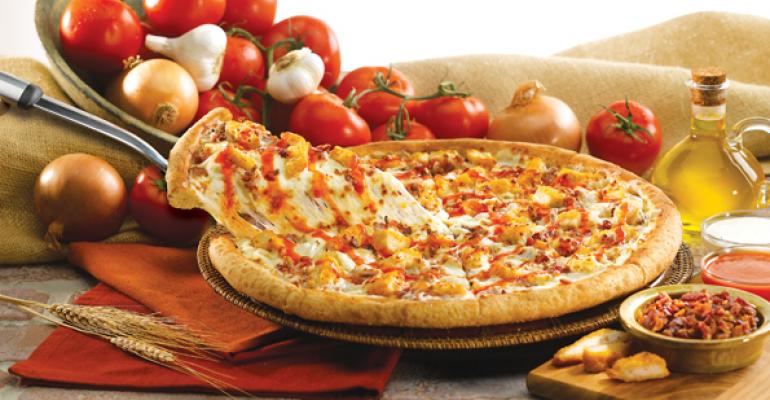Intensified competition in the pizza business ate into sales at Papa John’s International Inc. in the first quarter, the company said this week, but a couple of key promotions brought back traffic late in the period.
Domestic same-store sales were largely flat in the quarter ended March 27, up just 0.1 percent.
“Domestic [same-store sales] were a little lighter than usual,” CEO John Schnatter said on the company’s earnings call Wednesday. “We expect the rest of 2016 to be stronger as we continue to drive our sales with a quality message and our technology platform.”
Indeed, despite the weakness, the company reaffirmed its guidance of same-store sales growth of 2 to 4 percent for the full year. Steve Ritchie, the company’s president and chief operating officer, said “strong traffic toward the end of the quarter” gave the company confidence in that projection.
“It was a tale of two quarters,” Ritchie said. “We started off the year relatively light. Competitive activity was pretty aggressive. But we did make adjustments toward the tail end of the quarter and leading into the second quarter.”
Wall Street was thrilled with the explanation. The company’s stock price rose more than 6 percent through early afternoon trading Wednesday.
Revenues in the quarter fell 0.9 percent to $428.6 million from $432.3 million. Net income in the period increased 17.7 percent to $26.2 million, or 69 cents per share, from $22.2 million or 55 cents in the same period a year before.
Same-store sales at international markets, meanwhile, increased 5.7 percent. And systemwide unit count increased 0.2 percent to 4,903 locations.
The pizza business has long been competitive, as Pizza Hut, Domino’s Pizza Inc. and Papa John’s all battle for market share.
In recent years, Domino’s and Papa John’s were able to take market share while Pizza Hut’s sales were weak. But in the first quarter, Pizza Hut’s same-store sales rose 5 percent. And Domino’s same-store sales rose 6.4 percent while its CEO, Patrick Doyle, declared he didn’t think his company’s sales were affected by Pizza Hut’s resurgence.
Papa John’s executives said that the chain opted to spend the early part of the quarter focusing on its quality and its work to take unwanted ingredients from its pizzas.
At that time, other chains like Pizza Hut began focusing on price and value promotions to generate traffic.
“There could have been better timing,” Ritchie said. “But we did accomplish what we set out to accomplish, telling customers why Papa John’s is different.”
Toward the end of the quarter, he said, the chain shifted toward more “retail driven” promotions such as a $9.99 large, five topping pizza. That helped generate some traffic momentum toward the end of the quarter.
And Schnatter noted that the chain has taken the right strategy in focusing on more premium offers and its higher quality positioning, rather than concentrating on price.
He said that the chain’s sales have performed consistently over time, and usually recovers after price competition flares up.
“When they go from $5 to $4, because they well, they have to, we’ll probably feel it a little bit,” Schnatter said. “But we’ll feel is for 3-4-5 weeks and then we’ll get it back.”
Schnatter added that the early surge in competitive industry pricing is nothing the chain hasn’t seen before.
“Steve and I have been doing this combined for 65 years,” he said. “In 1993 when we went public, Pizza Hut was doing Big Foot Pizza. We’ve seen everything you can imagine. We’ve dealt with everything you can imagine.”
Contact Jonathan Maze at [email protected]
Follow him on Twitter at @jonathanmaze




